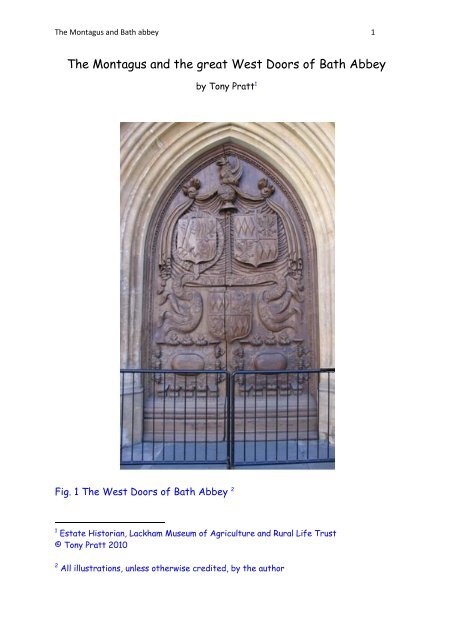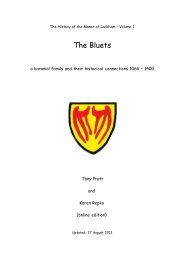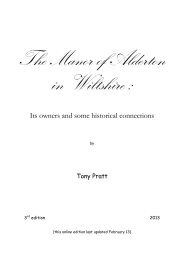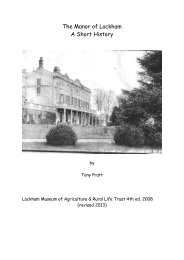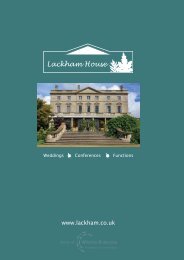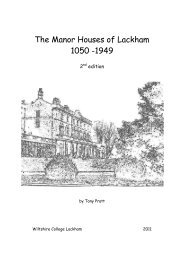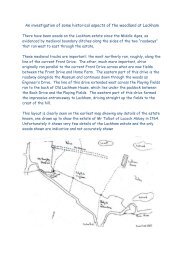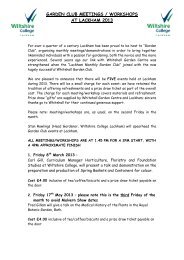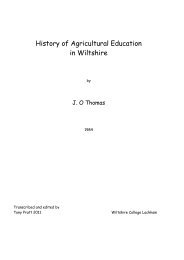The Montagus and the great West Doors of Bath Abbey - Lackham ...
The Montagus and the great West Doors of Bath Abbey - Lackham ...
The Montagus and the great West Doors of Bath Abbey - Lackham ...
You also want an ePaper? Increase the reach of your titles
YUMPU automatically turns print PDFs into web optimized ePapers that Google loves.
<strong>The</strong> <strong>Montagus</strong> <strong>and</strong> <strong>Bath</strong> abbey 1<br />
<strong>The</strong> <strong>Montagus</strong> <strong>and</strong> <strong>the</strong> <strong>great</strong> <strong>West</strong> <strong>Doors</strong> <strong>of</strong> <strong>Bath</strong> <strong>Abbey</strong><br />
by Tony Pratt 1<br />
Fig. 1 <strong>The</strong> <strong>West</strong> <strong>Doors</strong> <strong>of</strong> <strong>Bath</strong> <strong>Abbey</strong> 2<br />
1 Estate Historian, <strong>Lackham</strong> Museum <strong>of</strong> Agriculture <strong>and</strong> Rural Life Trust<br />
© Tony Pratt 2010<br />
2 All illustrations, unless o<strong>the</strong>rwise credited, by <strong>the</strong> author
<strong>The</strong> <strong>Montagus</strong> <strong>and</strong> <strong>Bath</strong> abbey 2<br />
<strong>The</strong> <strong>West</strong> <strong>Doors</strong> <strong>of</strong> <strong>Bath</strong> <strong>Abbey</strong> are <strong>of</strong> heraldic <strong>and</strong> historical significance<br />
as well as being wonderful to see. Inside <strong>the</strong> <strong>Abbey</strong> a plaque notes that<br />
”Sir Henry Montagu, L(ord) C(hief) J(ustice) 3 erected <strong>the</strong> <strong>great</strong> <strong>West</strong><br />
<strong>Doors</strong>” 4 in memory <strong>of</strong> his bro<strong>the</strong>r Bishop James Montagu. <strong>The</strong>y are<br />
adorned with elaborate carvings <strong>of</strong> three versions <strong>of</strong> <strong>the</strong> Montagu arms –<br />
<strong>the</strong> generic family arms, those <strong>of</strong> Bishop Montagu <strong>and</strong> those that appear<br />
to be <strong>of</strong> his bro<strong>the</strong>r Walter. <strong>The</strong>re are problems for <strong>the</strong> herald <strong>and</strong> <strong>the</strong><br />
historian with two <strong>of</strong> <strong>the</strong>se, which this paper will attempt to address.<br />
<strong>The</strong> Montagu arms are “Quarterly 1 & 4 Montagu Argent, three lozenges<br />
conjoined in a fesse gules within a bordure sable; 2 & 3 Mon<strong>the</strong>mer an<br />
eagle displayed vert beaked <strong>and</strong> membered gules” 5 i.e.<br />
Fig. 2 Arms <strong>of</strong> <strong>the</strong> Montagu family<br />
It has been noted that <strong>the</strong> Montagu arms<br />
ei<strong>the</strong>r with or without <strong>the</strong> bordure sable, were borne by <strong>the</strong><br />
Montacutes, Earls <strong>of</strong> Salisbury. John de Montacute, 2 nd son<br />
3 Chief Justice <strong>of</strong> <strong>the</strong> King’s Bench between 1616 <strong>and</strong> 1621<br />
4 Plaque on <strong>the</strong> north side <strong>of</strong> Bishop Montagu’s tomb, <strong>Bath</strong> <strong>Abbey</strong><br />
5 Brocklebank, Rev GR (1968) <strong>The</strong> Heraldry <strong>of</strong> <strong>the</strong> Church <strong>of</strong> St Cyriac, Lacock<br />
Uffington press p22
<strong>The</strong> <strong>Montagus</strong> <strong>and</strong> <strong>Bath</strong> abbey 3<br />
<strong>of</strong> <strong>the</strong> 1 st Earl <strong>of</strong> Salisbury, married <strong>the</strong> heiress <strong>of</strong><br />
Mon<strong>the</strong>rmer <strong>and</strong> <strong>the</strong>y appear, with <strong>the</strong> bordure sable on his<br />
tomb in Salisbury Ca<strong>the</strong>dral 6 . He died 1389/90, since which<br />
time all succeeding Montacutes, <strong>and</strong> on questionable<br />
authority <strong>the</strong> <strong>Montagus</strong>, have quartered <strong>the</strong> arms <strong>of</strong><br />
Mon<strong>the</strong>rmer 7<br />
<strong>The</strong> arms are seen in a number <strong>of</strong> places in <strong>the</strong> <strong>Abbey</strong>, most prominently<br />
on <strong>the</strong> <strong>West</strong> <strong>Doors</strong><br />
Fig. 3 Montagu arms on <strong>the</strong> <strong>West</strong> <strong>Doors</strong><br />
6 Brocklebank, Rev GR (1968) <strong>The</strong> Heraldry <strong>of</strong> <strong>the</strong> Church <strong>of</strong> St. Cyriac in Lacock <strong>The</strong><br />
Uffington Press comments that “this tomb, in <strong>the</strong> 4 th bay <strong>of</strong> <strong>the</strong> nave north side has<br />
three plain stone cots with no trace <strong>of</strong> colour – 1 plain Montacute, 2 Montacute impaling<br />
Mon<strong>the</strong>rmer <strong>and</strong> 3 Montacute quartering Mon<strong>the</strong>rmer. It is stated on <strong>the</strong> tomb that<br />
John “ fought at Crecy <strong>and</strong> died 1390”<br />
7 Kite, E (1899) Wilts Notes <strong>and</strong> Queries Vol 3 p173 fn1
<strong>The</strong> <strong>Montagus</strong> <strong>and</strong> <strong>Bath</strong> abbey 4<br />
but also on <strong>the</strong> ceiling <strong>of</strong> <strong>the</strong> Nave<br />
Fig. 4 Montagu arms in <strong>the</strong> Nave, <strong>Bath</strong> <strong>Abbey</strong><br />
<strong>The</strong> arms on <strong>the</strong> north side <strong>of</strong> <strong>the</strong> doors are those <strong>of</strong> Bishop James<br />
Montagu.<br />
James Montagu was <strong>the</strong> son <strong>of</strong> Edward Montagu <strong>of</strong> Boughton,<br />
Northamptonshire, <strong>and</strong> Elizabeth Harrington. He was born in about 1570<br />
<strong>and</strong> was a graduate <strong>of</strong> Christ's College, Cambridge. In 1595 he laid <strong>the</strong><br />
foundation stone <strong>of</strong> Sidney Sussex College, founded by his maternal <strong>great</strong><br />
aunt, Frances Sydney countess <strong>of</strong> Sussex. He was <strong>the</strong> College’s first<br />
Master between 1596 <strong>and</strong> 1609 8 . In 1603 he became dean <strong>of</strong> <strong>the</strong> Chapel<br />
Royal <strong>and</strong> dean <strong>of</strong> Lichfield.<br />
8 Venn, J & Venn, JA (1924) Alumni Cantabrigienses: A Biographical List <strong>of</strong> All Known<br />
Students, Graduates <strong>and</strong> Holders <strong>of</strong> Office at <strong>the</strong> University <strong>of</strong> Cambridge, from <strong>the</strong><br />
Earliest Times to 1900 part 1 vol iii p201<br />
to 1900; (1922
<strong>The</strong> <strong>Montagus</strong> <strong>and</strong> <strong>Bath</strong> abbey 5<br />
In 1604 he was made Dean <strong>of</strong> Worcester <strong>and</strong> Bishop <strong>of</strong> <strong>Bath</strong> <strong>and</strong> Wells in<br />
1608, where he remained until his translation to <strong>the</strong> See <strong>of</strong> Winchester in<br />
1616.<br />
It was while Bishop <strong>of</strong> <strong>Bath</strong> <strong>and</strong> Wells that James started <strong>the</strong> custom<br />
that, every year at Christmas, a sprig <strong>of</strong> <strong>the</strong> Glastonbury Thorn is cut by<br />
<strong>the</strong> Church <strong>of</strong> Engl<strong>and</strong> incumbent <strong>and</strong> sent to <strong>the</strong> Queen, which still<br />
continues. Montagu first sent a sprig to Queen Anne <strong>of</strong> Denmark, James<br />
I’s queen consort 9 , which dates <strong>the</strong> custom to between 1603 <strong>and</strong> 1617 10 .<br />
James was responsible for effectively completing <strong>the</strong> renovation <strong>of</strong> <strong>Bath</strong><br />
<strong>Abbey</strong>. <strong>The</strong> <strong>Abbey</strong> was in need <strong>of</strong> renovation after <strong>the</strong> Dissolution. In<br />
January 1539 <strong>Bath</strong> Priory was surrendered to Henry VIII’s<br />
commissioners by Prior Holloway, after which it was <strong>of</strong>fered to <strong>the</strong> City<br />
for <strong>the</strong> sum <strong>of</strong><br />
500 marks which were refused whereupon all <strong>the</strong> glass iron<br />
<strong>and</strong> lead belonging to it were sold to merchants <strong>the</strong> skeleton<br />
only <strong>of</strong> <strong>the</strong> building being left st<strong>and</strong>ing which with <strong>the</strong><br />
monastery were purchased by Humphrey Collis in 1542 11<br />
by which time much had fallen down. <strong>The</strong> first repairs were carried out in<br />
1572 12 when <strong>the</strong> eastern end was wea<strong>the</strong>rpro<strong>of</strong>ed. Queen Elizabeth<br />
allowed <strong>the</strong> citizens <strong>of</strong> <strong>Bath</strong> to raise money towards <strong>the</strong> work <strong>and</strong> a<br />
subscription towards completing <strong>the</strong> restoration was set up by <strong>the</strong><br />
Queen’s lord chamberlain 13 . He was followed by Walter Callcut <strong>of</strong><br />
9 Houghton, B (2006) Haunted Spaces p87<br />
10 <strong>The</strong> dates respectively <strong>of</strong> James <strong>and</strong> Anne’s Coronation <strong>and</strong> Montagu’s death.<br />
11 Saturday Magazine vol X p301 11 th March 1837 <strong>Bath</strong> Reference Library ref SP A5<br />
10B69<br />
12 Dougdale Monasticon Anglican (1819 edition) vol VI p261 “<strong>Bath</strong> Monastery” repairs<br />
by Peter Chapman<br />
13 Thomas (Radcliffe) , 3 rd earl <strong>of</strong> Sussex
<strong>The</strong> <strong>Montagus</strong> <strong>and</strong> <strong>Bath</strong> abbey 6<br />
Williamscot, Oxfordshire 14 . After this <strong>the</strong>re was a pause in <strong>the</strong> repairs<br />
until William, Lord Burleigh <strong>and</strong> his steward Thomas Bellot 15 continued <strong>the</strong><br />
work. <strong>The</strong>y completed <strong>the</strong> restoration <strong>of</strong> <strong>the</strong> Choir <strong>and</strong> <strong>the</strong> abbey was<br />
reconsecrated <strong>and</strong> dedicated to St Peter <strong>and</strong> St Paul, after which various<br />
people repaired <strong>the</strong> side aisles <strong>and</strong> <strong>the</strong> transepts. <strong>The</strong> west parts <strong>of</strong> <strong>the</strong><br />
Nave were uncovered in 1609 <strong>and</strong> were repaired by Bishop James “<strong>and</strong><br />
was followed by divers noblemen <strong>and</strong> gentlemen 16 ”.<br />
It would appear that James gave £1000 for <strong>the</strong> renovation, paid in annual<br />
installments <strong>of</strong> £100 pounds from 1602, <strong>and</strong> so before <strong>the</strong> remains <strong>of</strong> <strong>the</strong><br />
Nave were uncovered. <strong>The</strong> receipt for <strong>the</strong> final payment is held in <strong>the</strong><br />
Bodleian Library, Oxford 17<br />
14 It is also recorded that Callcut “left bequests for <strong>the</strong> poor <strong>of</strong> Banbury in <strong>the</strong><br />
sixteenth century” [Guppy, HB (1890)<br />
-1989 ed]<br />
Homes <strong>of</strong> Family Names in Great Britain p330<br />
15 Burleigh was Lord High treasurer to Queen Elizabeth I, <strong>and</strong> Thomas Bellot was also<br />
steward <strong>of</strong> her household as well as lord Burleigh’s. [<strong>The</strong> Penny Cyclopaedia <strong>of</strong> <strong>the</strong><br />
Societyfor <strong>the</strong> Diffusion <strong>of</strong> Knowledge (1835) vol III p22]<br />
16 Dougdale Monasticon Anglican (1819 edition) vol VI p261 “<strong>Bath</strong> Monastery repairs”<br />
by Peter Chapman<br />
17 b25 Bodleian Liibrary, transcribed from a negative photocopy in Hunt Collection vol 1<br />
p57 in <strong>Bath</strong> References Library Special Collection.<br />
25 Octobris 1611<br />
Receved this day <strong>and</strong> yeare aforesaid <strong>of</strong> <strong>the</strong> right reverend ffa<strong>the</strong>r in God James<br />
Bishop <strong>of</strong> <strong>Bath</strong> <strong>and</strong> Welles <strong>the</strong> sum <strong>of</strong> One Hundred Poundes <strong>of</strong> Lawfull money <strong>of</strong><br />
Engl<strong>and</strong> in full paymente <strong>of</strong> <strong>the</strong> sum <strong>of</strong> One Thous<strong>and</strong> Poundes <strong>of</strong> Lawfull money by him<br />
given towards <strong>the</strong> redeyfyinge <strong>of</strong> <strong>the</strong> church <strong>of</strong> St Peter <strong>and</strong> Paule in <strong>the</strong> Citty <strong>of</strong> <strong>Bath</strong><br />
aforesaid herewith .....wee saie <strong>the</strong> sum <strong>of</strong> One Thous<strong>and</strong> Poundes to <strong>the</strong> use aforesaid<br />
in witntnes where<strong>of</strong> wee have hereunto put or h<strong>and</strong>es <strong>and</strong> <strong>the</strong> seale <strong>of</strong> this City <strong>the</strong><br />
daie <strong>and</strong> yeare first above written Thomas Power Maior<br />
<strong>The</strong> donor <strong>of</strong> <strong>the</strong> copy, AE Ruse, made a pencilled note that Power was mayor in 1602<br />
<strong>and</strong> it would seem that Montagu’s gift... [was] made before he became bishop <strong>of</strong> <strong>Bath</strong><br />
<strong>and</strong> Wells
<strong>The</strong> <strong>Montagus</strong> <strong>and</strong> <strong>Bath</strong> abbey 7<br />
<strong>The</strong> concern <strong>of</strong> this paper, however, is <strong>the</strong> doors <strong>of</strong> <strong>the</strong> <strong>Abbey</strong> <strong>and</strong> <strong>the</strong><br />
arms upon <strong>the</strong>m. <strong>The</strong>re are a number <strong>of</strong> reasons to think that <strong>the</strong> doors<br />
as now seen are not as originally paid for by Sir Henry Montagu.<br />
<strong>The</strong> upper arms on <strong>the</strong> door display differences, those <strong>of</strong> <strong>the</strong> bishop <strong>the</strong><br />
annulet <strong>of</strong> <strong>the</strong> fifth son, which is correct as James was “filius<br />
quintogenitus 18 ” <strong>of</strong> his fa<strong>the</strong>r Edward.<br />
Fig. 5 Close up <strong>of</strong> Montagu arms on <strong>Bath</strong> <strong>Abbey</strong> doors<br />
However <strong>the</strong> arms on <strong>the</strong> right have a crescent. This is <strong>the</strong> difference <strong>of</strong><br />
<strong>the</strong> second son <strong>and</strong> would relate <strong>the</strong> arms to Henry Montagu’s bro<strong>the</strong>r<br />
Walter, who was <strong>the</strong> second son, <strong>and</strong> indeed this is <strong>the</strong> view currently<br />
held.<br />
It is known that <strong>the</strong> doors were “beautified” by Henry to, it has been<br />
said, honour his bro<strong>the</strong>rs James <strong>and</strong> Walter 19 but <strong>the</strong> contention that <strong>the</strong><br />
18 Memorial plaque on <strong>the</strong> south side <strong>of</strong> Bishop James’ tomb, <strong>Bath</strong> <strong>Abbey</strong><br />
19 Tabard Diamond Jubilee Issue An heraldic Walking Tour <strong>of</strong> <strong>Bath</strong> (2008) no 16,p10<br />
<strong>Bath</strong> Heraldic Society ISSN 0307-5397
<strong>The</strong> <strong>Montagus</strong> <strong>and</strong> <strong>Bath</strong> abbey 8<br />
memorial is to Walter appears to be solely based on <strong>the</strong> difference seen<br />
today relating to him. Walter was apparently born in 1565, married Anne<br />
Morgan at Boughton in 1593 <strong>and</strong> probably died in 1615 20 . This is only two<br />
years before <strong>the</strong> “beautification” <strong>of</strong> <strong>the</strong> doors, which may be an<br />
explanation.<br />
It is possible that <strong>the</strong> doors did not originally bear any arms at all; in his<br />
History from Marble (c 1670), Dingley recorded <strong>the</strong> inscriptions in <strong>Bath</strong><br />
<strong>Abbey</strong>. He noted 21 that<br />
<strong>The</strong> <strong>West</strong> <strong>Doors</strong> or Folding Gates <strong>of</strong> this Church <strong>of</strong> Curious<br />
artifice carry on <strong>the</strong> inside <strong>the</strong> Inscription concerning <strong>the</strong><br />
Donor thus in Pannells<br />
<strong>and</strong> included a rendering <strong>of</strong> <strong>the</strong> inscription :<br />
Fig. 6 Copy <strong>of</strong> Dingley’s record <strong>of</strong> <strong>the</strong> inscription on <strong>the</strong> inside <strong>of</strong> <strong>Bath</strong><br />
<strong>Abbey</strong> doors<br />
It is noted that <strong>the</strong> date <strong>of</strong> this inscription is 1617. It is important that<br />
this inscription was seen on <strong>the</strong> inside <strong>of</strong> <strong>the</strong> doors – when <strong>the</strong> Cambden<br />
Society published History from Marble it was made clear that <strong>the</strong><br />
inscription was “faded or painted over “ <strong>and</strong> it is certainly not visible<br />
now 22 . Henry is given as “Knight” because he was not created Baron<br />
Montagu until 1620. It is significant that Dingley makes no mention <strong>of</strong><br />
20 http://www.tudorplace.com.ar/MONTAGUE.htm#Walter MONTAGUE (Sir)1<br />
21 Dingley History from Marble Vol I Cambden Soc 1868 illustration on p xxvi<br />
22 Dingley History from Marble ibid
<strong>The</strong> <strong>Montagus</strong> <strong>and</strong> <strong>Bath</strong> abbey 9<br />
any carvings on <strong>the</strong> outside <strong>of</strong> <strong>the</strong> doors, as he certainly would have had<br />
<strong>the</strong>y been present - Dingley never missed an opportunity to illustrate<br />
arms in his work. <strong>The</strong> fact that <strong>the</strong> outside <strong>of</strong> <strong>the</strong> doors were<br />
“beautified” does not necessarily imply <strong>the</strong>y were carved with <strong>the</strong> Arms.<br />
<strong>The</strong> current interior <strong>of</strong> <strong>the</strong> doors are very different from <strong>the</strong> front – <strong>the</strong><br />
panelling that is clear in Dingley’s sketch is very evident but no trace <strong>of</strong><br />
<strong>the</strong> inscription remains, as noted above.<br />
<strong>The</strong>re are numerous images <strong>of</strong> <strong>the</strong> <strong>West</strong> Front <strong>of</strong> <strong>the</strong> <strong>Abbey</strong> held in <strong>the</strong><br />
<strong>Bath</strong> Library collections. <strong>The</strong> earliest apparently reliable image is dated<br />
1683 but unfortunately <strong>the</strong> doors are st<strong>and</strong>ing open <strong>and</strong> <strong>the</strong>ir faces<br />
cannot be seen 23 . <strong>The</strong>re is an earlier image, from Dugdale’s Monasticon 24<br />
which shows <strong>the</strong> doors as being plain on <strong>the</strong> outside. <strong>The</strong>re are concerns<br />
that this is not an accurate representation, however, as <strong>the</strong> interest here<br />
was to show <strong>the</strong> sculptures, <strong>and</strong> indeed almost none <strong>of</strong> <strong>the</strong> features on<br />
<strong>the</strong> west face <strong>of</strong> <strong>the</strong> <strong>Abbey</strong> are as <strong>the</strong>y are seen now 25 , <strong>and</strong> <strong>the</strong> fact that<br />
<strong>the</strong> door is shown as plain is not to be relied upon.<br />
In a picture <strong>of</strong> 1793 26 <strong>the</strong>re is something on <strong>the</strong> doors but it does not<br />
look like <strong>the</strong> arms we see today but in an illustration <strong>of</strong> 1798 <strong>the</strong> arms are<br />
clearly visible 27 . In that year <strong>the</strong> Society <strong>of</strong> Antiquaries published an<br />
23 By Nicholas Hawksmoor (1666-1736) sketchbook in <strong>the</strong> RIBA Library V&A, copy <strong>of</strong><br />
picture from <strong>Bath</strong> Chronicle & Herald Jan26 1952 I mage Reference 25749 Collection<br />
Reference A5 / 49 online at http://www.bathintime.co.uk/image.php?id=379303<br />
24 Image Reference 12628 Collection Reference LP A5 10B 50 <strong>Bath</strong> Libraries at<br />
http://www.bathintime.co.uk/image.php?id=199973<br />
25 Note that this is not <strong>the</strong> picture <strong>of</strong> <strong>the</strong> <strong>West</strong> <strong>Doors</strong> found in <strong>the</strong> 1819 edition <strong>of</strong><br />
Monasticon which is a plate drawn in 1815 by John Coney.<br />
26 Published Jan 26 1793. This version has <strong>the</strong> pinnacles. Image Reference 25768<br />
Collection Reference Hunt Vol I p47 10B 61 / 62 <strong>Bath</strong> Libraries at<br />
http://www.bathintime.co.uk/image.php?id=379346<br />
27 Plate VI from Some Account <strong>of</strong> <strong>the</strong> <strong>Abbey</strong> Church <strong>of</strong> <strong>Bath</strong>. Illustrations <strong>of</strong> <strong>the</strong> Plans,<br />
Elevations, <strong>and</strong> Sections <strong>of</strong> that Building. Engraved by James Basire from Drawings<br />
made by Mr John Carter, Architect. Published by <strong>the</strong> Society <strong>of</strong> Antiquaries <strong>of</strong> London,<br />
23rd April 1798 at http://www.bathintime.co.uk/image.php?id=15588
<strong>The</strong> <strong>Montagus</strong> <strong>and</strong> <strong>Bath</strong> abbey 10<br />
accurate survey <strong>of</strong> <strong>Bath</strong> <strong>Abbey</strong> <strong>and</strong> one <strong>of</strong> <strong>the</strong> illustrations shows <strong>the</strong><br />
<strong>West</strong> Front . <strong>The</strong> accuracy <strong>of</strong> this image is believed to be very high, given<br />
that this was a scale plan drawing <strong>of</strong> <strong>the</strong> <strong>Abbey</strong> <strong>and</strong> such small details as<br />
<strong>the</strong> lettering <strong>of</strong> <strong>the</strong> Garter motto around James’ arms are clearly shown.<br />
Fig. 7 Enlargement <strong>of</strong> <strong>the</strong> central part <strong>of</strong> <strong>the</strong> doors 1798 28<br />
From this drawing it is clear that <strong>the</strong> arrangement <strong>of</strong> <strong>the</strong> carvings on <strong>the</strong><br />
door was <strong>the</strong> same as today but that <strong>the</strong>y were not entirely <strong>the</strong> same; <strong>the</strong><br />
differences in <strong>the</strong> two upper arms seen today are not shown, circles being<br />
in <strong>the</strong>se positions. It is possible, <strong>of</strong> course, that this is an artefact <strong>of</strong><br />
<strong>the</strong> process <strong>of</strong> turning a drawing into an engraving <strong>and</strong> <strong>the</strong>n printing it.<br />
However it is also possible that this is a representation <strong>of</strong> <strong>the</strong> annulet<br />
that is properly James’ difference <strong>and</strong> shows that all three arms were his.<br />
28 Copyright to www.bathintime.co.uk - <strong>Bath</strong> Central Library Collection <strong>and</strong> reproduced with <strong>the</strong>ir<br />
permission
<strong>The</strong> <strong>Montagus</strong> <strong>and</strong> <strong>Bath</strong> abbey 11<br />
<strong>The</strong>re are questions, however, about <strong>the</strong> Bishop’s arms <strong>the</strong>mselves. <strong>The</strong>re<br />
are many examples <strong>of</strong> <strong>the</strong>m on his tomb<br />
Fig. 8 Arms on Bishop Montagu’s tomb<br />
<strong>and</strong> <strong>the</strong>se have been attributed to <strong>Bath</strong> Priory, “a red shield with a sword<br />
along one diagonal intersecting a pair <strong>of</strong> keys silver <strong>and</strong> gold along <strong>the</strong><br />
o<strong>the</strong>r” 29 .<br />
However <strong>the</strong>re is considerable doubt that <strong>the</strong>se are <strong>the</strong> arms <strong>of</strong> <strong>Bath</strong><br />
Priory. In 1676 Anthony à Wood noted <strong>the</strong> arms <strong>of</strong> <strong>the</strong> priory <strong>and</strong> See in<br />
one <strong>of</strong> <strong>the</strong> windows <strong>of</strong> a chapel attached to <strong>the</strong> south side <strong>of</strong> St James'<br />
church in <strong>Bath</strong> <strong>and</strong> said that<br />
29 Ede, J (1996) Heraldry in <strong>Bath</strong> <strong>Abbey</strong> p1
<strong>The</strong> <strong>Montagus</strong> <strong>and</strong> <strong>Bath</strong> abbey 12<br />
“<strong>The</strong>y are Az two keys indorsed in bend <strong>the</strong> upper argent<br />
<strong>the</strong> lower or enfiled with a sword in bend sinister 30 “<br />
<strong>The</strong>se arms can be dated to at least <strong>the</strong> end <strong>of</strong> <strong>the</strong> fifteenth century 31 .<br />
<strong>The</strong>y appear in Prior Cantalow’s lovely stained glass window in St<br />
Ca<strong>the</strong>rine’s church, located in <strong>the</strong> eponymous hamlet four miles north east<br />
<strong>of</strong> <strong>Bath</strong>. <strong>The</strong> arms in <strong>the</strong> window are given in Colinson’s 18 th century<br />
survey <strong>of</strong> Somerset as “<strong>the</strong> arms <strong>of</strong> <strong>the</strong> abbey viz a St Peter's key<br />
crossed with a sword “ 32 .<br />
Fig 9, Arms <strong>of</strong> <strong>Bath</strong> Priory 1499 from St Ca<strong>the</strong>rine’s church, St<br />
Ca<strong>the</strong>rine, <strong>Bath</strong><br />
30 Hick, EM (1913) <strong>The</strong> Ca<strong>the</strong>dral Church <strong>of</strong> SS Peter <strong>and</strong> Paul in <strong>the</strong> City <strong>of</strong> <strong>Bath</strong><br />
commonly called <strong>Bath</strong> <strong>Abbey</strong> p40<br />
31 Pevsner N (1957) Buildings <strong>of</strong> Engl<strong>and</strong> no vol or page number , excerpt in <strong>Bath</strong><br />
Reference Library Local Studies Pack - St Ca<strong>the</strong>rine transcribes <strong>the</strong> inscription<br />
on <strong>the</strong> window “Orate pro anima decani Johannis Cantlow qundam prioris (qui) hanc<br />
cancellam fieri fecit anno domini 1499 “<br />
32 Collinson, J (1791) <strong>The</strong> History <strong>and</strong> Antiquities <strong>of</strong> Somerset - Ka<strong>the</strong>rine or St<br />
Ka<strong>the</strong>rine [sic] no page numbers, excerpt in <strong>Bath</strong> Reference Library Local Studies Pack<br />
- St Ka<strong>the</strong>rine
<strong>The</strong> <strong>Montagus</strong> <strong>and</strong> <strong>Bath</strong> abbey 13<br />
<strong>The</strong>se are not <strong>the</strong> Priors arms (<strong>the</strong>y appear in <strong>the</strong> south window 33 ) but<br />
are those <strong>of</strong> <strong>Bath</strong> priory.<br />
So it is almost certain that <strong>the</strong> arms on Bishop Montagu’s tomb are those<br />
<strong>of</strong> Winchester, which was his seat when he died in 1617.<br />
Fig 10 Arms <strong>of</strong> <strong>the</strong> See <strong>of</strong> Winchester<br />
It is noteworthy that <strong>the</strong> arrangement <strong>of</strong> <strong>the</strong> gold <strong>and</strong> silver keys are<br />
here, in Winchester, reversed from that seen in <strong>Bath</strong> with <strong>the</strong> gold on top<br />
but<br />
Whe<strong>the</strong>r <strong>the</strong> keys are in bend or in bend sinister 34 <strong>the</strong> one<br />
which lies above <strong>the</strong> blade <strong>of</strong> <strong>the</strong> sword (be it higher or<br />
lower than <strong>the</strong> o<strong>the</strong>r) is <strong>the</strong> golden one. 35 ”<br />
33 Fig 11 Arms <strong>of</strong> Prior Cantlow, St Ca<strong>the</strong>rine’s Church, St Ca<strong>the</strong>rine<br />
34 Bend is <strong>the</strong> diagonal going from top left to bottom right <strong>of</strong> <strong>the</strong> shield, bend sinister<br />
goes top right to bottom left. Sinister items are deemed <strong>of</strong> lesser status than dexter<br />
ones.
<strong>The</strong> <strong>Montagus</strong> <strong>and</strong> <strong>Bath</strong> abbey 14<br />
It is difficult to see in Fig. 9 whe<strong>the</strong>r this is <strong>the</strong> case in St Ca<strong>the</strong>rine’s or<br />
not.<br />
Bishop Montagu seems to have used <strong>the</strong> arms described above, but<br />
instead <strong>of</strong> impaling <strong>the</strong>m with <strong>the</strong> saltire 36 <strong>of</strong> Wells in <strong>the</strong> ordinary<br />
manner he incorporated <strong>Bath</strong> by placing <strong>the</strong> keys <strong>and</strong> sword on <strong>the</strong> dexter<br />
<strong>and</strong> sinster, respectively, <strong>of</strong> <strong>the</strong> saltire <strong>of</strong> Wells.<br />
Fig 13 Bishop Montagu’s arms for <strong>the</strong> See <strong>of</strong> <strong>Bath</strong> <strong>and</strong> Wells<br />
35 Woodward, J (1894) Ecclesiastical Heraldry W&K Johnson, London & Edinburgh p74<br />
36 <strong>The</strong> use <strong>of</strong> a saltire is entirely correct; Wells Ca<strong>the</strong>dral is dedicated to St Andrew,<br />
whose cross it is albeit his would be ei<strong>the</strong>r argent or blanc. <strong>The</strong> saltire used in <strong>the</strong><br />
current arms <strong>of</strong> <strong>the</strong> See are “saltire quartered or <strong>and</strong> argent”,<br />
Fig 12 Current arms <strong>of</strong> <strong>the</strong> see <strong>of</strong> <strong>Bath</strong> <strong>and</strong> Wells
<strong>The</strong> <strong>Montagus</strong> <strong>and</strong> <strong>Bath</strong> abbey 15<br />
It has been said <strong>the</strong> he evidently “wished to express in heraldic language<br />
<strong>the</strong> pre-eminence <strong>of</strong> Wells over <strong>Bath</strong>” ” 37 but this would have been more<br />
evident if he had quartered <strong>the</strong> arms <strong>and</strong> placed those <strong>of</strong> <strong>Bath</strong> on <strong>the</strong><br />
sinister side, <strong>the</strong> arms seen in Fig 13 give equal importance to <strong>Bath</strong> <strong>and</strong><br />
Wells, <strong>the</strong> only pre eminence is that <strong>of</strong> <strong>the</strong> keys <strong>of</strong> St Peter to <strong>the</strong> sword<br />
<strong>of</strong> St Paul, <strong>and</strong> St. Peter was seen as <strong>the</strong> more important saint.<br />
<strong>The</strong> arms carved onto <strong>the</strong> <strong>West</strong> Door do not, <strong>of</strong> course, have any colour<br />
but <strong>the</strong>y do show this arrangement <strong>of</strong> keys <strong>and</strong> sword, with <strong>the</strong>m laying<br />
along <strong>the</strong> relevant diagonals but this makes <strong>the</strong> sword in bend <strong>and</strong> <strong>the</strong><br />
keys in bend sinister, <strong>the</strong> reverse <strong>of</strong> <strong>the</strong> Priory <strong>and</strong> early <strong>Abbey</strong> arms <strong>and</strong><br />
<strong>of</strong> Winchester<br />
Fig .14 Arms <strong>of</strong> Bishop Montagu on <strong>the</strong> <strong>West</strong> <strong>Doors</strong> today<br />
This is somewhat surprising for doors said to have been made by <strong>the</strong><br />
Bishop’s bro<strong>the</strong>r, who presumably knew <strong>the</strong> arms <strong>of</strong> his See very well.<br />
Interestingly this is not <strong>the</strong> only place where this arrangement is found;<br />
Woodward records that at Winchester<br />
Bishop Waynflete’s 38 [1447-1486] seals have a shield charged<br />
with a sword in bend <strong>and</strong> with a key or keys in bend sinister.<br />
37 Woodward, J (1894) Ecclesiastical Heraldry W&K Johnson, London & Edinburgh<br />
p177<br />
38 Bishop <strong>of</strong> Winchester 1447-1468, so roughly contemporary to Prior Cantlow at <strong>Bath</strong>
<strong>The</strong> <strong>Montagus</strong> <strong>and</strong> <strong>Bath</strong> abbey 16<br />
In <strong>the</strong> hall <strong>of</strong> New College oxford is a similar shield in painted<br />
glass with a field <strong>of</strong> azure this may possibly be <strong>of</strong> earlier<br />
date than Wayneflete’s seal but <strong>the</strong> tincture <strong>of</strong> <strong>the</strong> field is,<br />
so far as I am aware, unique 39<br />
Well, maybe not unique. Similar arms are used by <strong>the</strong> <strong>Abbey</strong> today. <strong>The</strong><br />
date <strong>of</strong> <strong>the</strong> change to <strong>the</strong>se arms is uncertain, even if those on <strong>the</strong> door<br />
do not how <strong>the</strong> colour, although <strong>the</strong> current arms are “certainly recorded<br />
in <strong>the</strong> 19 th century” 40 . It is noted, however, that <strong>the</strong> current arms do<br />
not follow <strong>the</strong> convention, seen above, that <strong>the</strong> sword lying over <strong>the</strong> keys<br />
is or.<br />
Fig. 15 Current arms <strong>of</strong> <strong>Bath</strong> <strong>Abbey</strong> 41<br />
That <strong>the</strong>se arms pre-date <strong>the</strong> nineteenth century <strong>and</strong> even be original to<br />
<strong>the</strong> doors, is shown by an engraving made in <strong>the</strong> late eighteenth century<br />
39 Woodward, J (1894) Ecclesiastical Heraldry W&K Johnson, London & Edinburgh p75<br />
40 Ede, J (1996) Heraldry in <strong>Bath</strong> <strong>Abbey</strong> p1<br />
41 From <strong>the</strong> gowns worn by <strong>the</strong> <strong>Abbey</strong> guides
<strong>The</strong> <strong>Montagus</strong> <strong>and</strong> <strong>Bath</strong> abbey 17<br />
Fig. 16 Bishops James’ arms from 1798 engraving 42<br />
<strong>The</strong>re is, however, an important difference between <strong>the</strong> 1798 engraving<br />
<strong>and</strong> <strong>the</strong> current doors. Beneath <strong>the</strong> arms runs part <strong>of</strong> <strong>the</strong> first line <strong>of</strong><br />
Psalm 113 “Ecce quam bonum, et quam jucundum habitare fratres in unum”<br />
[“Behold how good <strong>and</strong> pleasant it is for bro<strong>the</strong>rs to dwell toge<strong>the</strong>r in<br />
unity” 43 ] which would seem to be a very good quotation for doors<br />
commemorating one bro<strong>the</strong>r by ano<strong>the</strong>r. <strong>The</strong> doors do not exhibit <strong>the</strong><br />
entire line, however.<br />
42 Copyright to www.bathintime.co.uk - <strong>Bath</strong> Central Library Collection<br />
43 Translation available from many sources but in this case from Reyolds, JEIA (1978)<br />
<strong>The</strong> Works <strong>of</strong> <strong>the</strong> Right Rev John Engl<strong>and</strong> p215
<strong>The</strong> <strong>Montagus</strong> <strong>and</strong> <strong>Bath</strong> abbey 18<br />
Fig 17 Inscription on doors 1789 44<br />
<strong>The</strong> engraving clearly shows that it stops after <strong>the</strong> word “jucundum”,<br />
presumably because <strong>of</strong> lack <strong>of</strong> space, <strong>and</strong> refers to <strong>the</strong> rest <strong>of</strong> <strong>the</strong> (well<br />
known at least at <strong>the</strong> time) line by “etc”. <strong>The</strong> description <strong>of</strong> <strong>the</strong> doors in<br />
<strong>the</strong> Society <strong>of</strong> Antiquaries book confirms that<br />
under <strong>the</strong> two upper shields, on a label is <strong>the</strong> inscription<br />
'ecce quam bonum et quam jucundum etc’ 45<br />
Even a cursory glance at <strong>the</strong> current doors, however, will make it clear<br />
that in <strong>the</strong> current inscription “jucundum” is followed by “est”, <strong>the</strong> Latin<br />
for “is” which would fit better with <strong>the</strong> wording <strong>of</strong> <strong>the</strong> psalm but not with<br />
what is seen earlier.<br />
44 Copyright www.bathintime.co.uk - <strong>Bath</strong> Central Library Collection<br />
45<br />
Some Account <strong>of</strong> <strong>the</strong> <strong>Abbey</strong> Church <strong>of</strong> <strong>Bath</strong>. Illustrations <strong>of</strong> <strong>the</strong> Plans, Elevations,<br />
<strong>and</strong> Sections <strong>of</strong> that Building. Engraved by James Basire from Drawings made by Mr<br />
John Carter, Architect. Published by <strong>the</strong> Society <strong>of</strong> Antiquaries <strong>of</strong> London, 23rd April<br />
1798 in Collections Hunt vol 1 <strong>Bath</strong> Library
<strong>The</strong> <strong>Montagus</strong> <strong>and</strong> <strong>Bath</strong> abbey 19<br />
Fig. 18 <strong>The</strong> current inscription<br />
Once again this might be <strong>the</strong> result <strong>of</strong> ano<strong>the</strong>r error in <strong>the</strong> engraving.<br />
However <strong>the</strong>re are multiple records <strong>of</strong> <strong>the</strong> inscription, by authors as<br />
diverse <strong>and</strong> respected as John Britton 46 <strong>and</strong> Charles Dickens 47 , which all<br />
record it as ending with “etc”. This suggests strongly that <strong>the</strong> engraving<br />
is accurate <strong>and</strong> that <strong>the</strong> engravings now seen on <strong>the</strong> doors are not <strong>the</strong><br />
originals.<br />
When, <strong>the</strong>n, were <strong>the</strong> changes made? This is not certain but literary<br />
references continue to refer to “etc” until about 1875. It is worth<br />
noting, however, that this date cannot be supported strongly as re-issues<br />
<strong>of</strong> books are <strong>of</strong>ten not revised.<br />
It is unknown exactly how <strong>of</strong>ten or when <strong>the</strong> doors have been modified<br />
but it is known that in 1883 <strong>the</strong>re was a very large <strong>and</strong> important<br />
restoration <strong>of</strong> <strong>the</strong> <strong>Abbey</strong>, carried out under <strong>the</strong> supervision <strong>Bath</strong> City<br />
Architect GP Manners 48 , when <strong>the</strong> main <strong>West</strong> <strong>Doors</strong><br />
46 Britton, J (1829) <strong>The</strong> History <strong>and</strong> Antiquities <strong>of</strong> <strong>Bath</strong> <strong>Abbey</strong> Church p22<br />
47 All <strong>the</strong> Year Round 1875 vol 14 p826<br />
48 Hylson-Smith, K (1988) <strong>Bath</strong> <strong>Abbey</strong> : A History Friends <strong>of</strong> <strong>Bath</strong> <strong>Abbey</strong> p164
<strong>The</strong> <strong>Montagus</strong> <strong>and</strong> <strong>Bath</strong> abbey 20<br />
were repaired <strong>and</strong> renewed at <strong>the</strong> expence [sic] <strong>of</strong> <strong>the</strong><br />
Corporation by Mr. James Jones <strong>of</strong> this city in a manner most<br />
creditable to that able sculptor 49<br />
This might point <strong>the</strong> finger at <strong>the</strong> Victorian period for <strong>the</strong> changes; <strong>the</strong><br />
record <strong>of</strong> Victorian church ’restorers’ is, alas, appallingly bad when it<br />
comes to sensitivity to historical accuracy, or indeed anything else.<br />
<strong>The</strong>re have been o<strong>the</strong>r renovations, <strong>of</strong> course; Sir Gerge Gilbert Scott<br />
carried out <strong>the</strong> "<strong>great</strong>est face lift for two hundred <strong>and</strong> fifty years" 50<br />
between 1864-74 but work on <strong>the</strong> west front was curtailed because <strong>the</strong><br />
funds dried up <strong>and</strong> this was not worked on until 1895. <strong>The</strong>re is no record<br />
that <strong>the</strong> doors were worked on <strong>the</strong>n. <strong>The</strong>re were "important works to<br />
conserve, improve <strong>and</strong> enlarge <strong>the</strong> church buildings... in <strong>the</strong> twentieth<br />
century" 51 <strong>and</strong> <strong>the</strong> whole building, <strong>the</strong> outside <strong>and</strong> <strong>the</strong> inside were<br />
thoroughly renovated <strong>and</strong> cleaned under <strong>the</strong> <strong>Bath</strong> <strong>Abbey</strong> 2000 banner<br />
when <strong>the</strong> doors were cleaned at this time.<br />
To return to <strong>the</strong> heraldry yon <strong>the</strong> doors; it is unclear why <strong>the</strong> difference<br />
<strong>of</strong> a crescent was used on <strong>the</strong> right h<strong>and</strong> arms. If <strong>the</strong> annulet <strong>of</strong> Bishop<br />
James, which was previously seen <strong>the</strong>re (in <strong>the</strong> 1798 illustration), was not<br />
used it is possible that <strong>the</strong> restorers meant to use <strong>the</strong> arms <strong>of</strong> Henry<br />
Montagu, <strong>the</strong> donor. His arms correctly have a mullet, a five pointed,<br />
star, for difference, not <strong>the</strong> crescent seen on <strong>the</strong> door.<br />
Henry Montagu used <strong>the</strong> correct difference in his lifetime; on <strong>the</strong><br />
memorial to his fa<strong>the</strong>r, in Weekley parish church in Northamptonshire,<br />
Henry’s arms clearly show a mullet<br />
49 Peach, REM (1887) (ed) <strong>The</strong> History <strong>and</strong> Antiquities <strong>of</strong> <strong>Bath</strong> <strong>Abbey</strong>” by John Britton,<br />
p 44 fn 2 but probably taken from an original article in <strong>the</strong> <strong>Bath</strong> Chronicle 10 Dec 1883<br />
p3 ref: Hunt collection vol 1 (2) p47<br />
50 Hylson-Smith, K (1988) ibid p174<br />
51 Hylson-Smith, K (1988) ibid p180
<strong>The</strong> <strong>Montagus</strong> <strong>and</strong> <strong>Bath</strong> abbey 21<br />
Fig. 19 Arms <strong>of</strong> Henry Montagu on <strong>the</strong> tomb his fa<strong>the</strong>r, Weekley church<br />
<strong>Bath</strong> is not <strong>the</strong> only place where a (possible) mullet is today seen as a<br />
crescent. Henry Montagu’s son, Bishop James’ nephew, was also named<br />
James. He was <strong>the</strong> founder <strong>of</strong> <strong>the</strong> Wiltshire line <strong>of</strong> <strong>Montagus</strong> who lived<br />
at <strong>Lackham</strong> between Chippenham <strong>and</strong> Lacock. <strong>The</strong>re is a memorial to<br />
James, <strong>and</strong> his wife Mary Baynard, in St Cyriac’s Church, Lacock, which<br />
naturally includes <strong>the</strong> arms <strong>of</strong> James <strong>of</strong> <strong>Lackham</strong>.<br />
When Dingley compiled his survey <strong>of</strong> church monuments in Engl<strong>and</strong> 52 he<br />
noted that this monument bore <strong>the</strong> difference 53 <strong>of</strong> “Montagu, with a<br />
mullet, quartering Mon<strong>the</strong>rmer “, which is correct as James was Henry<br />
Montagu’s third son <strong>The</strong> memorial now (2010), however, <strong>and</strong> despite being<br />
faded, very clearly shows a crescent. It is noteworthy that nei<strong>the</strong>r <strong>of</strong><br />
<strong>the</strong> o<strong>the</strong>r Montagu arms shown on memorials in St Cyriac’s shows a<br />
difference.<br />
52 Died 1695<br />
53 Dingley History from Marble Cambden Soc 1868 p153
<strong>The</strong> <strong>Montagus</strong> <strong>and</strong> <strong>Bath</strong> abbey 22<br />
Fig. 20 Arms <strong>of</strong> James Montagu <strong>and</strong> Mary Baynard in St Cyriac’s, Lacock<br />
with <strong>the</strong> centre section enlarged<br />
<strong>The</strong> <strong>Lackham</strong> Aisle was refurbished, in this case by ano<strong>the</strong>r owner <strong>of</strong><br />
<strong>Lackham</strong> one Henry Berney Caldwell, in 1862 <strong>and</strong> it seems likely that <strong>the</strong><br />
change to <strong>the</strong> memorial was made at this time. However that is some 20<br />
years before <strong>the</strong> refurbishment <strong>of</strong> <strong>Bath</strong> <strong>Abbey</strong> in 1883 <strong>and</strong> it is hard to<br />
see why Mr Jones, if he were responsible, would have followed <strong>the</strong><br />
example from Lacock. Does this point to one <strong>of</strong> <strong>the</strong> later restorations<br />
being responsible for <strong>the</strong> changes seen on <strong>the</strong> doors? Whatever is <strong>the</strong><br />
case <strong>the</strong> fact, that <strong>the</strong>re is a local example where an expected mullet has<br />
been changed to a crescent, lends credence to <strong>the</strong> idea that <strong>the</strong> same<br />
thing could, <strong>and</strong> did, happen at <strong>Bath</strong> <strong>Abbey</strong>.<br />
In conclusion <strong>the</strong>re is no direct evidence that <strong>the</strong> arms seen on <strong>the</strong> <strong>great</strong><br />
<strong>West</strong> <strong>Doors</strong> <strong>of</strong> <strong>Bath</strong> <strong>Abbey</strong> were put <strong>the</strong>re by Henry Montagu. Although<br />
not impossible <strong>the</strong>re is some evidence that <strong>the</strong>y post date <strong>the</strong> erection <strong>of</strong><br />
<strong>the</strong> doors. It is certain that <strong>the</strong> current details are not those recorded<br />
at <strong>the</strong> end <strong>of</strong> <strong>the</strong> eighteenth century but <strong>the</strong> date <strong>of</strong> <strong>the</strong> changes is not<br />
certain. Hopefully fur<strong>the</strong>r research will answer <strong>the</strong> questions raised in<br />
this paper.


